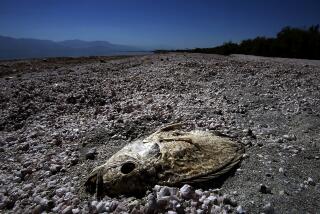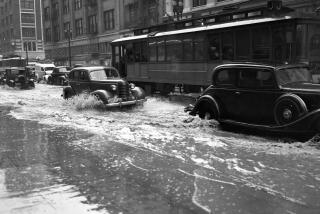CALIFORNIA ALBUM : Dust to Dust : Owens Lake, once a vacation spot, is now a salty environmental hazard. It dried up in 1924, when Los Angeles siphoned away its water.
KEELER, Calif. — An ad in an 1872 Owens Valley newspaper invited valley residents on a holiday lark--a Fourth of July steamship excursion across the blue, rolling waters of Owens Lake.
They would leave from a wharf on the northern shore and churn 15 miles across the salt lake to a delightful picnic spot. According to a written account of the expedition, the party spent the hot summer day eating, drinking, dancing to band music and generally enjoying the outdoors.
Today, there are no ships on Owens Lake, and people don’t hold many picnics along its shores.
The saline lake, which once covered more than 100 square miles of the Owens Valley, dried up in 1924 after engineers for the city of Los Angeles diverted the Owens River into the newly built Los Angeles Aqueduct. In doing so, they turned the lake into a vast, dry salt pan, and created an environmental nightmare unmatched in the United States.
Winds that roar across the salt flat with nothing to break their momentum raise huge, billowing clouds of powdery clay and salt dust. The dry lake bed produces the highest readings of particulate air pollution in the nation, up to 12 times the federal standard.
Even more alarming for people who live here, the Environmental Protection Agency calls the dust kicked up by the winds extremely hazardous--the ultra-fine particles can cause lung damage.
Not that many people live in the dust zone. Inyo County, tucked on the east side of the Sierra Nevada, has only about 18,000 residents, and most of them live around Bishop, 60 miles north of the lake bed.
But enough are here that the EPA has given the Great Basin Unified Air Pollution Control District a 1994 deadline for thinking up a solution to the dust storms. The rural agency and its 15 employees have until 2001 to get the problem fixed.
The task is trickier than it might seem. The obvious solution, refilling the lake with water, was ruled out when it became clear that would require permanently tying up the entire flow of the Owens River, one of Los Angeles’ primary sources of water.
Some fairly wild solutions have been proposed over the years, most of them never taken very seriously by the pollution agency’s scientists. The suggestions have included covering the vast lake bed with railroad ties, car tires, gravel, or mulch collected from the Inyo National Forest and local gardens.
Those kinds of approaches were ruled out last year by the State Lands Commission, which oversees the lake bed and wants its scenic value and wildlife habitat protected. One hundred square miles of car tires or gravel would not do much to enhance the views from U.S. 395, which runs beside the dry lake, or from the 14,000-foot Sierra Nevada peaks that tower above.
The projects now considered most promising involve sprinklers to wet the dust or flooding the most problematic sections of the lake bed. Creating new wetlands on the lake bed most prone to blowing dust would not only stabilize the surface, but might make it possible to provide habitat for waterfowl and other birds.
“At the same time as it keeps the dust from blowing, the water would leach some of the salt out of the soil so that we might be able to grow vegetation on the lake bed,” said Duane Ono, deputy air pollution control officer.
Another approach under study involves the construction of fences to create specially arrayed dunes that would block sand from blowing across the lake bed and churning up the powdery alkaline dust.
Naturally occurring sand dunes on the lake bed already reach a height of 40 feet, part of a landscape so other-worldly that Owens Lake was used for filming scenes of a dust-blown galactic wasteland in the movie “Star Trek V.”
Among the geological oddities are 10-foot-high, haystack-shaped formations called spring mounds that have bubbled up near an area of warm springs at the bed’s southern end. There are also undetectable bogs of quicksand where unwary walkers have fallen in up to their waists.
When an answer to the dust conundrum is finally found, it will come as good news to Jeanne Lopez. She lives in Keeler, one of the little hamlets hard by the lake’s edge, and describes dust clouds that can envelop the town in a matter of minutes, turning sunny days into dim brooding ones.
“It really is terrible,” Lopez said. “They call it ‘Keeler fog.’ People who live here try to filter the air in their houses, or to make them airtight. At our house, we have plastic sheets over the windows, but the dust gets in anyway.
“It’s like a coating of fine talc that sits on everything. When I die, I’m leaving my body to science,” she said jokingly.
More to Read
Sign up for Essential California
The most important California stories and recommendations in your inbox every morning.
You may occasionally receive promotional content from the Los Angeles Times.










